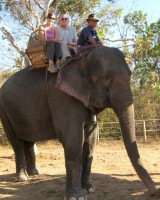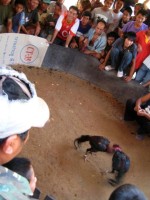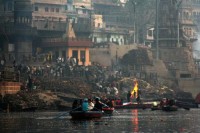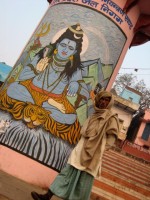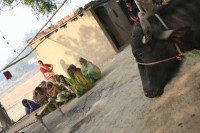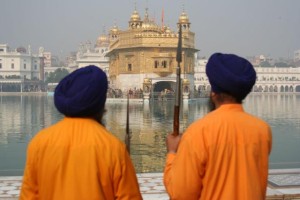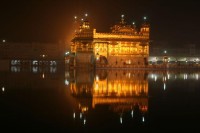
I’ve heard travelers say that, when it comes to foreign experiences, there’s India, and then there’s the rest of the world. No place is this more true than in Delhi. ((I’ve always been confused about the difference between “Delhi” and “New Delhi.” From what I’ve read, it seems that “Delhi” encapsulates both “Old Delhi”–the capital of pre-British, Islamic India–and “New Delhi,” which was constructed by the Brits as their imperial capital.)) Our family has an apartment in Delhi, and the promise of both their company and free lodging kept us there for more than two weeks. In that time–longer by far than we’ve spent in any other place on our itinerary–we got to know at least three of Delhi’s multiple personalities. Allow me to introduce you to The Good, The Bad and The Wildly Confusing.
The Good:
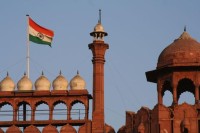
Delhi boasts both an incredible past and a wonderfully vibrant present. We had a great time touring its many attractions and fell particularly in love with the Red Fort, where a tour guide ((In the past four months, we’ve learned that a good tour guide–generally hired at the location we’re touring and for that location alone; we fear the umbrella-led tour group–can really help us get the most out of the places we’re visiting. We always talk with the guide first to ensure that he or she speaks great English. And then we bargain. Hard.)) made the place come alive for us as he described the luxuries that existed within its thick, sandstone walls during the reign of the Mughal emperor who ruled from there.  We also really enjoyed exploring Humayun’s tomb, an amazing example of Mughal architecture that looks a lot like the Taj Mahal’s little brother.
Another highlight was a visit to the sprawling, 2005-built Akshardam Temple. The fact that it felt a little like Disney World at times (never before have I seen a food court in a place of worship…) didn’t completely undermine its astonishingly intricate marble and sandstone carvings. A lot of the temple is still being constructed, so we were able to watch artisans as they created the marvels that, 500 years from now, someone will look at in wonderment and say “how did they make something like that way back then?”.
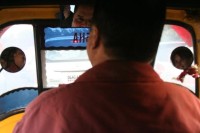
The evenings that we spent at an assortment of wedding and new year’s festivities demonstrated to us how incredibly alive and colorful Indian culture is. Old traditions and new mixed and thrived at these incredible events, where the outstanding food and the vibrating music served as constant reminders that this country really knows how to throw a party. Watching 20-somethings honor their religion and their family through age-old traditions and seeing grandparents on the dance floor, grooving to a techno remix of Om Shanti Om, I felt proud to be half-Indian. Sadly, my impressions of Delhi didn’t end there.
The Bad:

Right down the street from those luxurious parties, people live in slums, burning trash to stay warm as their children turn cartwheels in the crowded streets to try to earn a few rupees from spectators watching from the safety of their cars. While Delhi’s economy is growing, the gap between the rich and the poor seems terrifyingly wide. India has the largest population of child laborers in the world (estimated by human rights groups at an astounding 60 million), and this fact is dramatically illustrated throughout Delhi’s streets.
Speaking of streets, the traffic in Delhi is so bad that it’s almost comical. (We could laugh at the traffic delays because, given our blessedly easy lives at the moment, we rarely had to be anywhere at a certain time. I can’t imagine the stress that would accompany having to actually arrive someplace at a certain hour.) We had to allow 45 minutes to an hour to get anywhere by car. Happily, Delhi has a sparkling new subway system that will hopefully alleviate some of the strain on its roads.
For now, all of those cars, trucks, buses and auto-rickshaws are teaming up to create some wicked air pollution. I often felt like I was breathing in solid particles (probably because I was…) and, when I ran a white washcloth over my face at the end of the day, the cloth turned gray. What’s more, Delhi’s streets are littered with trash unlike any I’ve ever seen. Every corner seems to be growing its own landfill. The environmental situation is bad and getting worse, which leads me to…
The Wildly Confusing:

India has environmental laws, but they’re often not enforced. It has traffic laws (surely?), but the only traffic police I saw in Delhi were the ones helping to control the scene of an accident. It may even have anti-littering laws but, from the state of things, those would seem to be a waste of the paper on which they’re written. The lawyer in me mourned for the lack of law and order in Delhi. (That’s the lowercase “law and order”; I’m can almost guarantee that the TV show is regularly available on cable.) I polled the locals, i.e., my family members, on the cause of this sorry state of affairs. Many of them pointed the finger at corrupt government officials. The thinking seems to go like this: why bother following the law when it’s cheaper and easier just to bribe the government official tasked with enforcing it? It pained me.
Less painful but similarly bothersome were the gaggles of ogling young men that seemed to lurk around every corner. They rarely spoke, but they followed me, took pictures of me and stared so much that I bought sunglasses to avoid having to make eye contact with them. Even the “I’m going to really hurt you if you don’t stop staring at my wife” looks constantly given by the 6″4 Derek rarely seemed to phase them. I know that Delhi is not alone in this annoyance–friends living in the Middle East and Latin America complain of more of the same, and it’s certainly commonplace throughout India as a whole–but I was never able to figure out (1) why the men were staring and (2) why they weren’t embarrassed by their own behavior. ((India has been more focused lately on the harassment perpetuated there by some men. On New Year’s Eve, two California-based Indian women were attacked by a gaggle of men as they left a Bombay night club. A press photographer got it all on film, and the ugly scene has since been splashed across the front pages of India’s many newspapers.))
Although Delhi’s challenges made it somewhat more difficult to enjoy, enjoy it we did. The city has so much in store for travelers–from ancient ruins to modern dance clubs, from bustling markets to shiny new shopping malls–that it’s worth the effort it takes to uncover its gems.




